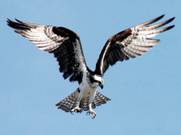|
"Your gateway to
understanding |
Osprey

- Well adapted for hunting fish
- Pairs mate for life
- Populations are rebounding, and can now be seen around Oneida Lake
Ospreys are large raptors, and may reach 55cm (22 inches) in length with a wingspan of 135cm (54 inches). Besides having a white cap on the back of the head, individuals have brown topsides. They have a white chin, throat, breast, and belly, and have a brown tail decorated with white bands. From underneath, the wings are white with black bars, and are flat with a kink at the elbow. Even at a distance, the unmarked white belly, distinctive wing shape, and unique flight style make the osprey instantly recognizable. Adults will typically live for 20–25 years.
Ospreys locate fish from the air, often hovering before plunging feet-first into the water. As the osprey again takes flight, the fish is held head first to reduce drag. This style of hunting relies on shallow water, which Oneida Lake has in abundance, and ospreys can frequently be seen patrolling the shoreline. Ospreys have adapted well to a fish diet, and possess reversible outer toes, closable nostrils to keep out water during dives, and backwards facing claw scales that act as barbs when holding prey. These 'barbed' claws are so effective at grasping fish that an osprey may be unable to release one that is too heavy. This can cause the osprey to fall back into the water, where it must swim to shore or drown.
Ospreys mate for life, and breed by freshwater lakes or coastal brackish waters. In spring they begin a five-month period of partnership to raise their young. Nests are composed of large heaps of sticks, and are built in trees, rocky outcroppings, telephone poles, and artificial platforms. Females lay 3–4 eggs within a month, and rely on the size of the nest to help conserve heat. The eggs are approximately the size of chicken eggs, and are cinnamon colored; they are incubated for about five weeks to hatching. The newly-hatched chicks weigh only 50–60g (2 oz), but fledge within eight weeks. In some regions with high osprey densities, no nesting sites are available and individuals are forced to delay breeding until they are five to seven years old. If this is a problem, humans may set up posts to provide sites artificially.
Twenty to thirty years ago, ospreys faced local extinctions because the species could not produce enough young to maintain the population. However, with the banning of DDT in the early 1970s, and with public awareness that has reduced persecution, ospreys have made significant recoveries. Osprey nests are abundant throughout Cicero Swamp, and adults have been spotted hunting over Fisher Bay and around the entire Oneida Lake shoreline.
To learn more about Osprey...
